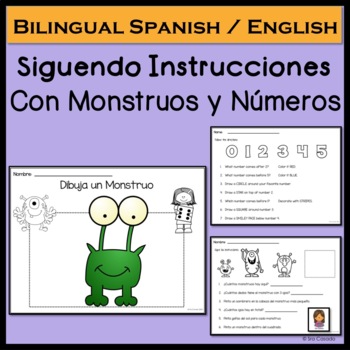Follow Directions Activity | Directed Drawing Game | Bilingual Spanish English
- PDF
Description
Bilingual students will love these games and activities to practice following directions, siguiendo instrucciones. Geared toward Spanish or English speaking Kindergarten or 1st grade students, it is a great opportunity to practice spatial awareness, and reinforce number and shape recognition. You can also practice using position words “below, above, next to, etc.” Finally, it builds self confidence as students practice their small motor skills.
and can be used in centers, homework, or as a class or small group activity. Perfect for ELL, Bilingual, Dual Language, or Immersion classes.
[ T A R G E T • S T U D E N T ]
-------------------------------------------------------------------------------------------------
- Kindergarten and 1st grade students.
- This pack is bilingual and has a version in English and in Spanish.
Spanish version is geared toward Spanish Bilingual / Dual Language / Immersion) students.
[ P R O D U C T • I N C L U D E S ]
-------------------------------------------------------------------------------------------------
There are 14 pages to this packet. Each game / instruction / activity is in Spanish and English.
Activities: Students follow directions to:
- color and draw simple shapes using numbers 0-5.
- color and draw simple shapes and objects (and their own monster!) and answer simple questions.
- answer keys included.
Game:
- Directions to the monster drawing game using body part vocabulary, number vocabulary, and following directions.
- List of body parts handout.
- Monster drawing page
Common Core Aligned:
CCSS.K.CC.B.4
CCSS.K.CC.B.5
CCSS.K.CC.C.7
CCSS.K.MD.A.2
[ C O P Y R I G H T ]
-------------------------------------------------------------------------------------------------
This resource was designed and copyrighted by © Sra Casado. All rights are reserved. With the purchase of this resource you have permission to print and copy it for single classroom use only. Electronic sharing and distribution is prohibited. Additional licenses can be purchased as needed at a discounted price.
Please do not hesitate to send me a message at jencasado@gmail.com if you have any questions about the product.
[K E E P • I N • T O U C H!]
-------------------------------------------------------------------------------------------------
• Follow me on Instagram (@sra_casado) and my blog Sracasadoteachesbilinguals.blogspot.com for tips, freebies, and to see my products in action!
Follow my TpT store to know about discounts, freebies and product launches:
• Click on the green star next to my store logo. Yay! You will now receive email updates about Sra Casado!
Get TPT credit to use on future purchases:
• Log in and go to your “My Purchases” page. Click on the “Provide Feedback” button next to your purchase. You will be taken to a page where you can give a quick rating and leave a short comment for the product. Yay! Now you have credit from TpT and I am able to learn more about what products work for you!





